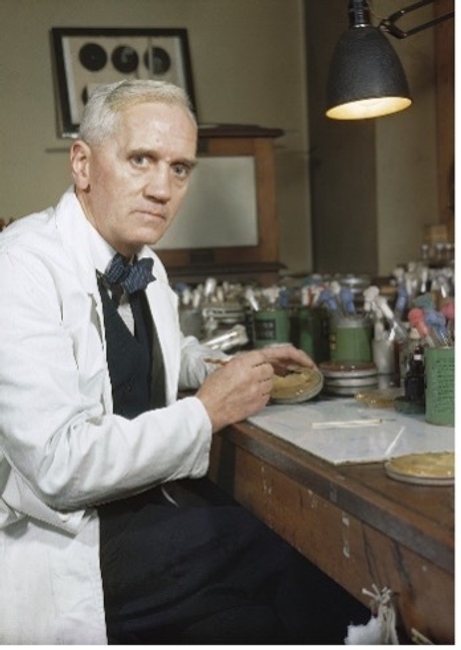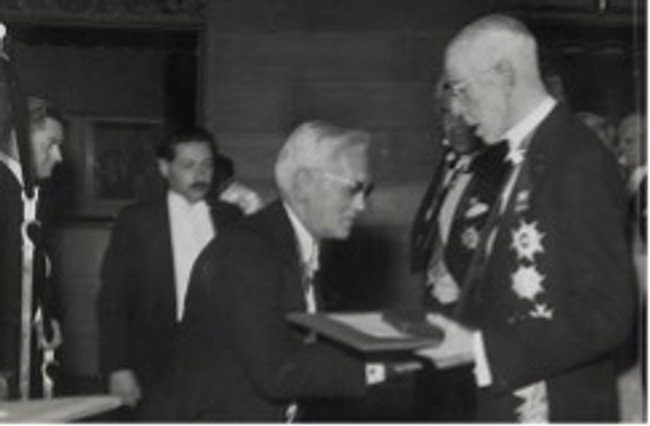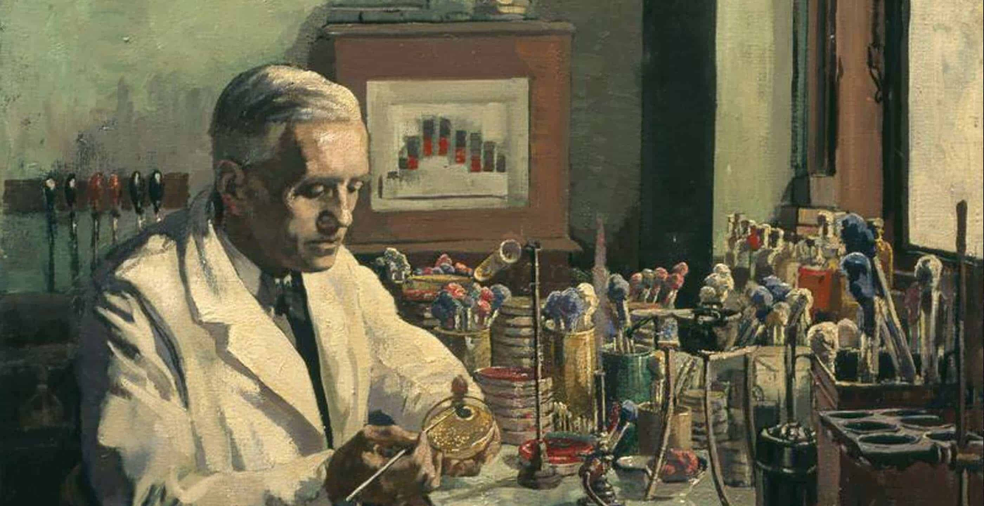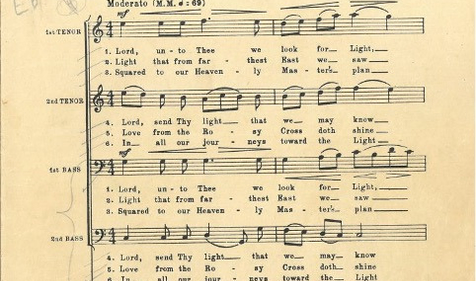Sir Alexander Fleming was a Scottish physician, microbiologist, and Freemason who discovered penicillin, the world's first effective antibiotic.
“The unprepared mind cannot see the outstretched hand of opportunity." – Sir Alexander Fleming
Freemasons are united by their shared values and desire to seek light and meaning through service to others. Known for our intellectual curiosity, our Brethren have long sought to uncover the great mysteries of the universe, helping to shape history along the way. We're proud to note our Brothers have been behind some of the most important breakthroughs in medicine and science, Brothers like Sir Alexander Fleming. With humble beginnings in rural Scotland, Worshipful Brother Fleming's discovery of penicillin, the world's first effective antibiotic, profoundly impacted how physicians today treat patients.
From Lochfield to London
Alexander Fleming was born on August 6, 1881, on Lochfield farm in Darvel, Scotland. The 800-acre farm, which still stands today as a holiday getaway, was owned by Hugh Fleming and Grace Stirling Morton, the daughter of a neighboring farmer. Located in a remote part of the country, Alexander was one of seven children that spent much of their time exploring the countryside's streams, valleys, and moors. Fleming learned to observe the natural world closely and later said of his childhood, "We unconsciously learned a great deal from nature."
Young Fleming attended Loudoun Moor for his elementary schooling before moving to a larger school at Darvel. At 13, he earned a two-year scholarship to Kilmarnock Academy where he continued demonstrating his academic potential. In 1895, he moved to London to expand his educational opportunities. He lived in the city with his elder brother Thomas (who worked as an oculist) and studied at Regent Street Polytechnic for three years before economic hardship forced him to leave school and work as a clerk for a shipping company.
Four years later, Brother Fleming turned 20 and received an inheritance from his uncle, John Fleming, that allowed him to pursue a career in medicine. He put the inheritance toward attending medical school at St. Mary's Hospital in Paddington and eventually graduated at the top of his class in 1906.
A Fortunate Decision
From 1900 to 1914, Brother Fleming served as a private in the London Scottish Regiment of the Volunteer Force. During his time in medical school, he also joined the rifle club, which proved to have a profound influence on his future and, consequently, the future of medicine. The young man had quickly earned a reputation as an expert marksman, and the club captain wanted Brother Fleming to stay on the team. To convince him to remain, he suggested, quite successfully, that Alexander join the research department at St Mary's.
After finishing his studies at St. Mary's, he worked as a research assistant under Sir Almroth Wright, the head of the school's Inoculation Department and a vaccine therapy and immunology pioneer. In 1908, Brother Fleming received his M.B., B.S. and began preparing for a career in surgery, although he was uncertain if this was the right path for him. He continued working under Wright while he studied for the Fellowship of the Royal College of Surgeons exam. While he ultimately passed the exam and was accepted as a fellow in 1909, he became interested in the blood's natural bacterial action and antiseptics. He chose to remain in Wright's laboratory and pursue research rather than become a practicing surgeon. As history shows, it was the right decision, and Brother Fleming remained part of this research group for the rest of his career.

Lessons From the Battlefield
In 1914, Brother Fleming became a commissioned lieutenant and was promoted to captain in 1917. He served in the Royal Army Medical Corps throughout World War I, working alongside many of his colleagues in battlefield hospitals on the Western Front in France. Here, he saw how many of his fellow soldiers died not from their wounds, but from the aggressive infections they couldn't temper.
At the time, physicians primarily used antiseptics to combat infection, often exacerbating the severity. Prior to the war, the German chemist-physician Paul Ehrlich developed a chemical treatment for syphilis named salvarsan. Before salvarsan, syphilis treatments were toxic enough that they often killed the patients to whom they were administered. Ehrlich brought his groundbreaking treatment to London, and Brother Fleming became one of the few physicians able to administer salvarsan through the difficult technique of intravenous injection.
In the battlefield hospitals, Brother Fleming saw how infections often killed soldiers with stunning quickness, despite their simplicity. Fleming wrote of his observations in an article describing the presence of anaerobic bacteria in deep wounds, which proliferated despite antiseptics. He surmised that there must be a chemical, like salvarsan, that could help fight microbe infection and was able to innovate new treatments.
A Profound Breakthrough
The medical community was not quick to embrace Brother Fleming's research on antiseptics. Undaunted by the critical feedback of his peers, he pressed on and, in 1922, discovered lysozyme, an enzyme that causes bacteria to disintegrate. The story goes that Brother Fleming transferred some of his nasal mucus onto a Petri dish while infected with a cold. His workstation wasn't known for being well organized and, amongst the clutter of his desk, the petri dish sat forgotten for two weeks.
As it sat, numerous colonies of bacteria grew and proliferated. However, the area where the mucus had been inoculated remained clear. Upon further investigation, Brother Fleming discovered the presence of a substance in the mucus that inhibited bacterial growth: lysozyme. Although subsequent experiments revealed that this enzyme was effective against a small number of non-harmful bacteria, it was a foundational discovery for Brother Fleming's most significant medical breakthrough.
On September 3, 1928, he returned to his lab after vacationing with his family in Suffolk to continue his study of staphylococci. He inoculated staphylococci on culture plates and left them on a bench in the corner of his laboratory while he was gone and returned to find one culture contaminated with a fungus. The colonies of staphylococci surrounding the fungus – which he later identified as Penicillium notatum (now classified as P. chrysogenum), - had been destroyed, whereas other staphylococci colonies farther away were normal.
Excited by the possibility of finding a more potent enzyme than lysozyme, Brother Fleming investigated further. As it turned out, the enzyme was an antibiotic, and one of the first to be discovered. Now acting as a professor of bacteriology at St. Mary's, he had the freedom to research whatever he deemed of interest and chose to pursue the therapeutic development of penicillin. Although he could not stabilize and purify penicillin, he wrote of its clinical potential as a topical antiseptic and an injectable antibiotic. Brother Fleming and his team struggled to produce penicillin in large amounts, and, as a result, the research was met with little enthusiasm by the medical community.
The Nobel Laureate

Little progress was made toward isolating his "precious mold juice" in large quantities for years. In 1940, Fleming was gearing up for retirement just as two Oxford scientists, Howard Florey, and Ernst Chain, became interested in penicillin and began studying its molecular structure. They successfully developed a method of purifying penicillin to an effective, stable form. After the success of the subsequent clinical trials, they developed techniques for mass production and mass distribution in 1945, just in time for use during World War II. It is estimated that using penicillin to treat wounded Allied forces during the war significantly reduced the number of deaths and amputations by 12 – 15 percent. After the war ended, Australia and the United States made penicillin available to the public.

That same year, Brother Fleming, Florey, and Chain shared the 1945 Nobel Prize in Physiology or Medicine for developing penicillin. Brother Fleming downplayed his part in developing penicillin while praising Florey and Chain. Nevertheless, his role was essential as the first to discover penicillin and for keeping, growing, and distributing the mold for twelve years until a chemist came along with enough skill to make it into a more widely used drug.
The Man and the Mason: Worshipful Brother Sir Alexander Fleming
Brother Fleming was known for being quiet, patient, and modest. He was not emotional, and his shyness made him an ineffective lecturer. Despite his reticence, he completed the three degrees of the Blue Lodge and, in 1909, Brother Fleming was initiated into London's Sancta Maria Lodge No. 2682 when he was 27. He served as Senior Warden in 1922 and Master in 1924.
Additionally, he joined London Scottish Rifles Lodge No. 2310 in London in 1911 and Misericordia Lodge No. 3288 in London in 1925, where he served as Master in 1935. He was awarded the London Grand Rank in 1934 and was appointed Senior Grand Deacon by the United Grand Lodge of England in 1942. He was also promoted to Past Senior Grand Warden in 1948.
Brother Fleming married an Irish nurse named Sarah Marion McElroy in 1915. They had a son named Robert Fleming, who became a general practitioner. Thirty-four years after they married, Sarah passed away, which affected Brother Fleming profoundly. He buried himself in his work and remained single until 1953, when he married Dr. Amalia Koutsouri-Vourekas.
For his contributions to medicine, Brother Fleming has received countless awards and recognitions, such as:
- Fleming, Florey, and Chain jointly received the Nobel Prize in Medicine in 1945.
- Fleming was knighted, as a Knight Bachelor, by King George VI in 1944.
- Sir Fleming served as President of the Society for General Microbiology,
- He was a Member of the Pontifical Academy of Science and an Honorary Member of almost all the medical and scientific societies of the world.
- He was awarded a doctorate, honoris causa, and degrees from almost 30 European and American Universities.
- Fleming was awarded the Medal for Merit by the Brother and President of the United States, Harry Truman.
- Fleming was made a Grand Cross of the Legion of Honour by the French Republic.
- Fleming was made a Grand Cross of the Order of the Phoenix of Greece.
- He was made a Knight Grand Cross of the Order of Alfonso X the Wise (Spain) in 1948.
- In 1999, Fleming was named one of the 100 Most Important People of the 20th Century by Time magazine.
Brother Fleming died from a heart attack on March 11, 1955. While he downplayed the importance of his scientific work in life, his legacy is evident: penicillin changed the world of modern medicine by introducing the age of helpful antibiotics. Penicillin has saved and continues to save millions of lives globally.
Related Stories
Discover additional Scottish Rite blogs and news on this topic.



